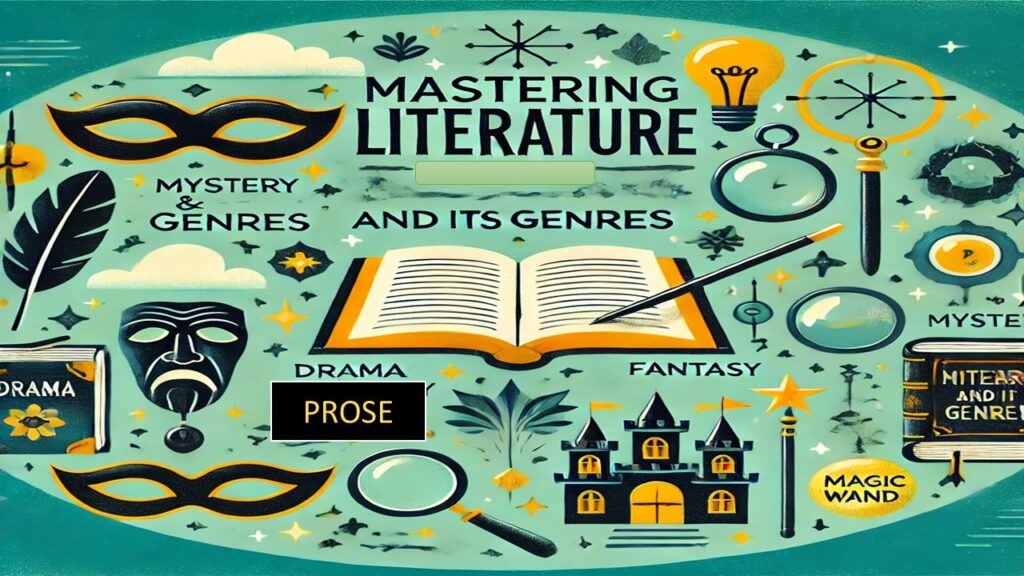Introduction
Mastering Literature and its genres is not only essential for exam success, but also a means to travel the world from the comfort of your home. For students, tutors, and exam candidates like those preparing for WAEC, NECO, GCE, and JAMB, understanding literature is not just academic; it’s a journey into the human psyche and the diverse expressions of life. Literature allows readers to experience diverse cultures, places, and historical periods without physically traveling. Through novels, poetry, and other genres, readers can explore different parts of the world, gain insights into different ways of life, and develop a global understanding. This blog delves into the rich tapestry of literature, exploring its major genres and their significance.
What is Literature?
Literature encompasses written works that possess artistic merit and convey ideas, emotions, and narratives. Literature may be defined as the sum total of all works, whether oral or written, that have helped to reflect and project the life and culture of a people. It spans a broad spectrum, including prose, poetry, and drama, each offering unique insights and aesthetic experiences. Historically, literature has evolved from ancient oral traditions to contemporary digital forms, adapting to cultural and technological changes. This evolution reflects the shifting landscapes of human thought and society, making literature a vital study area for understanding historical contexts and cultural developments. This evolution mirrors the changing dynamics of human thought and society, making literature an essential field for exploring historical contexts and cultural transformations.
Functions of Literature
Major Genres of Literature
Genres in literature categorize works based on shared characteristics, themes, and stylistic elements. Recognizing these genres helps readers and scholars appreciate the diversity of literary expression and analyze texts more effectively. Understanding genres is crucial for exam candidates, as it enables them to categorize and critique texts accurately.
Drama
Drama is a genre intended for performance, using dialogue and action to tell a story. It encompasses various sub-genres, each with distinct characteristics:
- Tragedy: Dramatic works that explore human suffering and often end in disaster. Examples include “Hamlet” by William Shakespeare and “Death of a Salesman” by Arthur Miller.
- Comedy: Light-hearted and humorous plays that often end happily. Examples include “A Midsummer Night’s Dream” by William Shakespeare and “The Importance of Being Earnest” by Oscar Wilde.
- Tragicomedy: Blends elements of tragedy and comedy, often featuring serious themes with a hopeful resolution. Examples include “Waiting for Godot” by Samuel Beckett.
- Farce: A sub-genre of comedy with exaggerated characters and improbable situations. Examples include “The Importance of Being Earnest” by Oscar Wilde and “Noises Off” by Michael Frayn.
Drama engages audiences through live performances, emphasizing the power of dialogue and action to convey stories and emotions. It’s a crucial genre for understanding human interactions and societal dynamics.
Prose
Prose is a genre that involves imaginary events and characters, crafted to entertain, inform, or inspire readers. It’s a realm where creativity and storytelling reign supreme. Prose can be divided into several sub-genres:
- Novel: Long, detailed narratives with complex plots and characters. Examples include “Pride and Prejudice” by Jane Austen and “1984” by George Orwell.
- Short Story: Brief, focused narratives that usually explore a single incident or character. Examples include “The Lottery” by Shirley Jackson and “The Tell-Tale Heart” by Edgar Allan Poe.
- Novella: A mid-length narrative, longer than a short story but shorter than a novel. Examples include “Animal Farm” by George Orwell and “The Metamorphosis” by Franz Kafka.
Fiction allows readers to explore different realities, empathize with diverse characters, and ponder over hypothetical scenarios. It’s a critical genre for developing imagination and understanding complex human behaviors and societal issues.
Poetry
Poetry is a genre that emphasizes the aesthetic and rhythmic qualities of language. It often employs meter, rhyme, and vivid imagery to evoke emotions and convey deep meanings. Poetry comes in various forms:
- Sonnet: A 14-line poem with a fixed rhyme scheme. Examples include Shakespeare’s sonnets and “Sonnet 43” by Elizabeth Barrett Browning.
- Haiku: A three-line poem with a 5-7-5 syllable structure, originating from Japan. Examples include works by Matsuo Basho.
- Free Verse: Poetry without a fixed meter or rhyme scheme. Examples include “Leaves of Grass” by Walt Whitman and “The Waste Land” by T.S. Eliot.
Poetry challenges readers to engage with language on a deeper level, appreciating its beauty and the layers of meaning within. It’s a critical genre for developing linguistic sensitivity and emotional depth.
Conclusion
Literature, with its myriad genres, offers a profound exploration of human experience and expression. For students, tutors, and exam candidates, delving into these genres not only enhances academic performance but also enriches personal growth and empathy. Whether through the imaginative realms of fiction, the factual landscapes of non-fiction, the emotive depths of poetry, or the dynamic performances of drama, literature invites us to understand and appreciate the complexities of life. Embrace the diversity of literary genres to broaden your horizons and deepen your understanding of the world.



